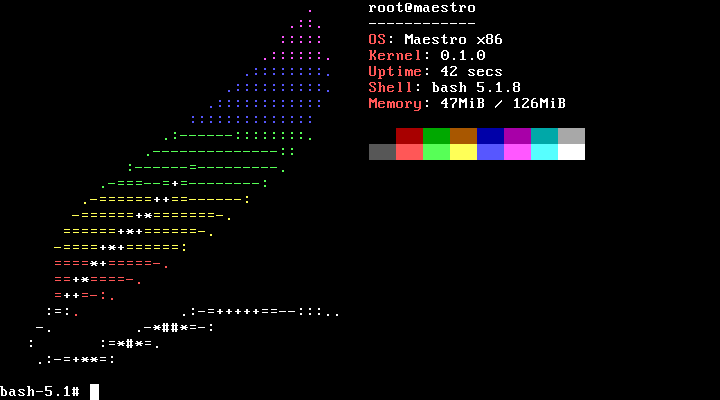- cross-posted to:
- hackernews@lemmy.smeargle.fans
- cross-posted to:
- hackernews@lemmy.smeargle.fans
Enter Maestro, a unix-like monolithic kernel that aims to be compatible with Linux in order to ensure wide compatibility. Interestingly, it is written in Rust. It includes Solfége, a boot system and daemon manager, maestro-utils, which is a collection of system utility commands, and blimp, a package manager. According to Luc, it’s creator, the following third-party software has been tested and is working on the OS: musl (C standard library), bash, Some GNU coreutils commands such as ls, cat, mkdir, rm, rmdir, uname, whoami, etc… neofetch (a patched version, since the original neofetch does not know about the OS). If you want to test it out, fire up a VM with at least 1 GB of ram.
This sounds cool, but troubling because of its license. Trying to write a linux compatible kernel and licensing as MIT is basically asking to get railroaded by gigantic organizations. I hope they reconsider in the future.
because of its* license
Thanks :)
deleted by creator
deleted by creator
Its a bit if an issue with the rust ecosystem in general tbh. Wish more stuff was copyleft >.<
Could someone detail why? Why is MIT license troublibg?
MIT is basically “do anything you want with it, I don’t care”. I means some company can reuse it in its closed source projects freely and without notice or royalty.
There are plenty of other licenses that require you to also go open source if you include and/or modify it. Basically “you can use ot however you want, but if you modify it, it has to be open source as well”
According to Luc, its* creator
Keep fighting the good fight. Syntax is important.
Yes. Thank you, “It’s no tits”!
Username checks out
N O T I T S
Username checks out?
I think that’d be sugar chest
BUT WHAT WE MAKE
It snot its
50MB for a sub POSIX kernel and a shell prompt for a 50MB ISO image that has less functionality than a 4KB kernel (L4SEC) which has actual formal proofs of correctness.
Well, I guess it has Rust as a selling point but that isn’t something that should matter if the goal is real security.
Started as a school project
I wouldn’t take it so seriously, it’s a passion project from a person learning about Rust and OS structure. Don’t compare this project against industry professionals.
Why not ? Even Linux started as a personal fun project. Let’s see where it will go
For sure, but making an OS is not a one man job anymore.
Bah gaw. Terry Davis would say you “glow in the dark.”
I knew there would be at least one TempleOS reference in this thread lmao
Finally, some “exciting” news, 2031 will be the year of the linux desktop(and Maestro)!
It’s interesting, but with Linux and BSD already available in many different flavours do we really need it?
I mean what use case would it be better in except maybe an extreme rust enthusiast.
do we really need it?
Asked no programmer ever before starting a project
If it’s cool (as this is), then yes. It’s needed :-)
It isn’t needed to be required for one to like developing it.
With minix already available I see no reason why we need a Linux kernel
Whats the need for it? Another great operating systems engineer emerging from it even though the project itself might not be ‘useful’. You only truly learn stuff when actively doing it.
One day he might be a significant contributor to Linux!
- Memory safety is super important
- Rust is far more approachable than C, so contribution and iteration is easier
- Did we really need an OS when Linux was released? It wasn’t the first.
It was the first fully working kernel licenced under a FOSS licence. So it was the first time someone could run a 100% open source OS.
At least since maybe some really old mainframe back when stuff came with source code
But, but… rust?!!
it’s not that everybody should work solely on what you deem useful/needed, eh
Why?
Because someone decided to do it.
You don’t always need a good reason other than it might be cool/fun. Sometimes it’s just because you can.
You’re not forced to use it, so if it’s not your cup of tea, that’s fine.
When my wife asks me “why are you doing [insert weird thing of the moment in my homelab]?” most of the times I answer “because I can!”.
When my wife asks me “why are you doing [insert weird thing of the moment in my homelab]?” most of the times I answer “because I can!”.
Exactly!
He answers that in the project page. Just because there are kernels available, he can’t build his own and learn about kernel and computers in general (the answer for your question)
written in Rust.
And …why?
Contributing to Linux can be extremely daunting. Refactoring can be as well. Rust makes both of those a LOT easier. If a project is written in Rust instead of C there will be many more potential contributors and flexibility.
And Rust has a restrictive trademark policy which could theoretically cause problems. Especially because of how full the source code of Rust is of the trademarks.
Just, why, Mozilla?
deleted by creator
A VM with 1GB of RAM but the screenshot shows 50MB in use?
Oh, looks like the install live environment needs it.
You should’ve read the article, ”You should run the ISO with sufficient RAM (1GB should be more than enough). Such an amount of memory is required because packages to be installed are stored in RAM (on the initramsfs) instead of the disk. This is currently the best method since the OS is not yet able to read on a USB stick or CD-ROM by itself, so it relies on the bootloader for this. ”
I guess you could run on lower ram, but package installs require more.
I did read the article, reason of my edit













